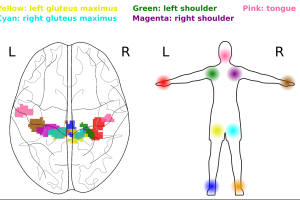Info about the Project
Most high-speed non-invasive BCI typing systems require intense visual attention and feedback. BrainBraille investigates a more open-loop approach similar to touch typing. BrainBraille enables communication at 20 characters per minute (cpm) by monitoring attempted movements in the motor cortex. Using functional Magnetic Resonance Imaging (fMRI). Users attempt to tense the muscles for six body parts: the hands, the feet, the tongue, and the gluteus maximus. Those actions activate the corresponding six regions of the motor cortex, which map to the six dots in a Braille cell.
Faculty: Dr. Thad Starner, Dr. Melody Jackson
Students: Yuhui Zhao
Most high-speed non-invasive BCI typing systems require intense visual attention and feedback. BrainBraille investigates a more open-loop approach similar to touch typing. BrainBraille enables communication at 20 characters per minute (cpm) by monitoring attempted movements in the motor cortex. Using functional Magnetic Resonance Imaging (fMRI). Users attempt to tense the muscles for six body parts: the hands, the feet, the tongue, and the gluteus maximus. Those actions activate the corresponding six regions of the motor cortex, which map to the six dots in a Braille cell.
Faculty:
Dr. Thad Starner, Dr. Melody Jackson
Students:
Yuhui Zhao



